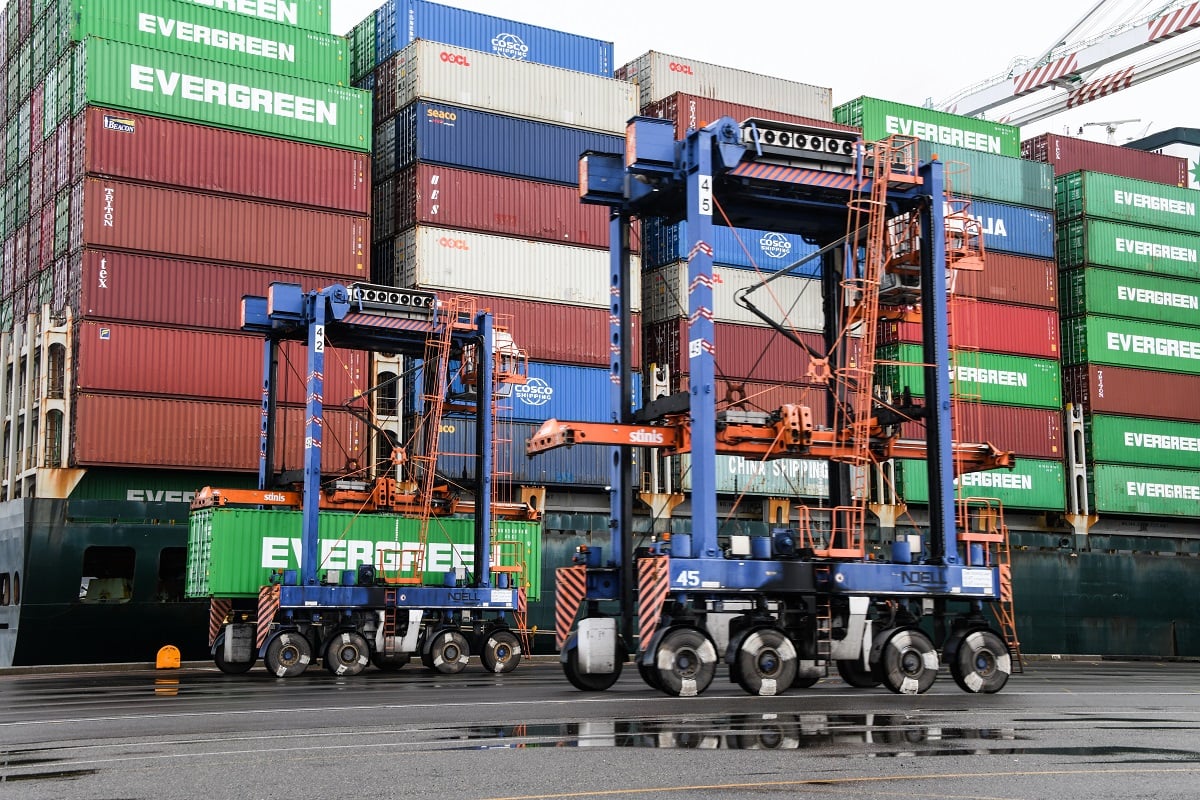Putting the Yokohama RR42 to the Test at the Port of Tacoma
With over 95% percent of imported cargo entering the U.S. arriving by ship, ports play a critical role in the global supply chain. It’s at ports where containers from around the world are transferred for further distribution via inland transportation such as rail and truck and vice versa. Ports like Pierce County Terminal in Tacoma, Washington, employ a variety of equipment to keep goods moving, including straddle carriers that depend on tires like the Yokohama RR42 to keep them operating at peak levels of performance.
Straddle Carriers at the Port of Tacoma
Straddle carriers are extremely tough on tires, most notably when turning. The combination of heavy loads, high center of gravity, and abrasive surfaces puts a large amount of lateral force on a tire—which strains sidewalls and can lead to cracking—along with grinding away valuable rubber.
The straddle carriers can travel at 18 miles per hour, lift up to 50 metric tons, and feature eight wheels, each capable of steering. This allows operators in the cab towering 42 feet above to make tight turns and precise maneuvers while navigating the bustling port. It also puts considerable strain on tires.
Challenges Facing Straddle Carrier Tires
Straddle carriers are extremely tough on tires, most notably when turning. The combination of heavy loads and the abrasive surfaces straddle carriers work on puts a large amount of lateral force on a tire—which strains sidewalls and can lead to cracking—along with grinding away valuable rubber.
Straddle carriers also work long shifts, day in and day out on hot asphalt (particularly during the summer), which generates a lot of heat that the tire must dissipate. Heat is the #1 enemy of tires—it can speed up tire wear and increase the likelihood of tire failure, which is something that a straddle carrier operator working approximately three stories above the ground doesn’t want to think about. As Ed Cornish pointed out in Tire Review, workers will refuse to operate machinery with tires they deem unsafe.
Enter the Yokohama RR42
The Yokohama RR42 was designed to meet the real-world challenges posed to port tires and to excel in busy port operations. How do they perform? Ed Cornish put eight of them to the test at Everport's Tacoma railyard, which, in his words, is “the hardest area to make a tire last.” The railyard has a reputation for chewing up tires.
Tires working at the railyard must contend with uneven terrain and abrasive surfaces like asphalt and concrete along with traveling over steel rails. Increasing the challenge is that tires working at the rail are often making 180-degree turns with half the tire on asphalt and half the tire on concrete, which really grinds away at a tire’s rubber. Consequently, straddle carrier tires used at the railyard often have about one-third less life than tires used dockside.
How the Yokohama RR42 Performed
According to Cornish, the Yokohama RR42 was an upgrade over the other straddle carrier tires they’ve been using at the port. On average, one of Cornish’s straddle carrier tires typically delivers 2,800 to 3,500 hours of service, but he estimates that the RR42 will last between 3,200 and 4,000 hours—a significant improvement that could substantially reduce his tire cost per hour.
Furthermore, Cornish has found that the RR42 has enough flexibility in the sidewall to resist the grinding of turns, the strength to resist the strain of lateral force, and the stability required for a machine carrying 50 metric tons operated by a worker perched more than 40 feet in the air.
Other Benefits Provided by the Yokohama RR42
While Cornish is excited about the long-lasting service he’s seen from the Yokohama RR42, there are some notable elements of the tire that help it deliver its impressive performance.
The RR42 tread pattern features two deep circumferential grooves which help to minimize vibration and reduce tread wear. According to Cornish, another benefit of the double grooves is that it makes them easier for mechanics to handle—a huge bonus, considering the RR42 weighs almost 600 pounds. The tread also incorporates shallower diagonal grooves that allow it to better dissipate heat and travel at faster speeds.
An unseen ally to Cornish and his fleet of straddle carriers are the advanced compounds designed to resist wear and heat used to create the Yokohama RR42.
Yokohama Off-Highway Tires America
Yokohama Off-Highway Tires America has an ever-expanding range of port tires designed to meet the demands of the busy ports of today and the future. Of course, don’t take our word for it—listen to what Ed Cornish has to say about his experience using the Yokohama RR42 tire. We’re sure after listening to Cornish, you’ll want to contact your local dealer or rep and let us put our tires to work for you.

